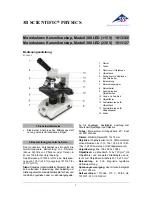
9
III. OBSERVING OPERATION
1. Turn down the power switch in order to switch on the illumi-
nation. The power switch also works as a brightness control
knob.
2. By turning the nosepiece, set the 10x objective into the ope-
ration position. Then focus the specimen, which is on the
stage.
3. Adjust the interpupillary distance and the diopter (for binocular
observation).
4. Adjust the up & down position of the condenser, the light
control and the aperture diaphragm in order to get a satisfying
luminal effect. When you watch with the 4x or 10x objective,
bring down the condenser to get symmetrical light. When you
watch with the 4x objective, put the auxiliary lens of conden-
ser in observation position.
5. When you interchange objectives, turn the nosepiece and
refocus slightly with the fine focusing knob. When you use the
100x objective, be sure to put a drop of immersion oil between
the objective and the specimen as well as between the con-
denser and the slide.
IV. THE OPERATIONS OF EACH UNIT
1. Adjustment of interpupillary distance (Fig. 4)
Fig. 4
Put the specimen on the stage and bring it into the exact focus.
Adjust the interpupillary distance of the binocular viewing by
“folding” the binocular tube (1) on the optical head, until the right
and the left field of view can be composed to one.
2. Adjustment of diopter (Fig. 4)
Put the specimen on the stage. Turn the 40x objective to the
working position. Firstly, observe at the right eyepiece with the
right eye; adjust the coarse and fine focusing knob to image
clearly. Secondly, observe at the left eyepiece with the left eye;
adjust the diopter control (2) to image clearly.
3. Coarse/Fine focusing (Fig. 5)
Fig. 5
The instrument uses a coaxial coarse/fine focusing mecha-
nism. The knob for tensional adjustment of focusing (4) is
used for adjusting the tension of the coarse focusing knob
(3) to prevent the stage from naturally sliding down. The li-
mit knob (1) prevents accidental contact between specimen
and objective. After locking the limit knob (by turning up and
fastening) at a chosen height of the stage, you cannot focus
the object closer to the objective using the coarse focusing
knob. So, the object is protected against damage. (2) is the
fine focusing knob.
4. Stage (Fig. 6)
Fig. 6
The convenient specimen holder (1) on the stage is used for
holding the slide glass (2). The longitudinal (lengthwise) ad-
justment knob (3) and the transversal (cross) adjustment knob
(4) are coaxial. The stage moves expediently.
5. Adjustable Abbe condenser (Fig. 7)
Fig. 7
The condenser is moved up or down via turning the up-down
knob (1). For centering, the condenser centering screws (6)
are used. The condenser can be taken down easily if one un-
screws the condenser holding screw (2). The place for a filter
plate is on the filter seat (5).
6. Power switch and adjustable brightness (Fig. 7)
Turn down the power switch (3). Adjust the light control (4)
until the image can be observed comfortably. Note: Don‘t let
the light control at the position of maximum brightness for a
long time. That reduces the life-span of the lamp.
B
C
E
D C
B
B
C
D
E
D
B
E
G C
F
DE
AT
CH
GB
IE
FR
CH
BE


































